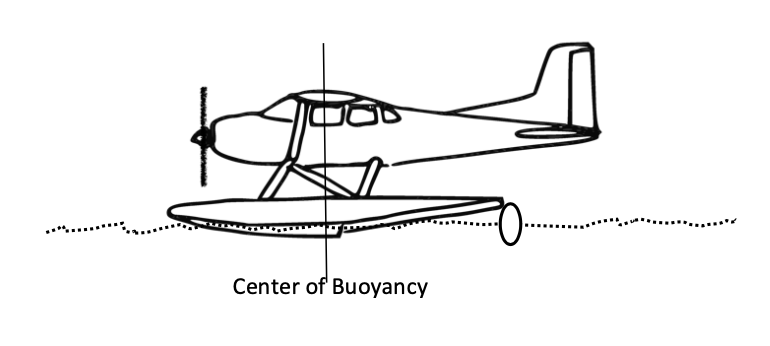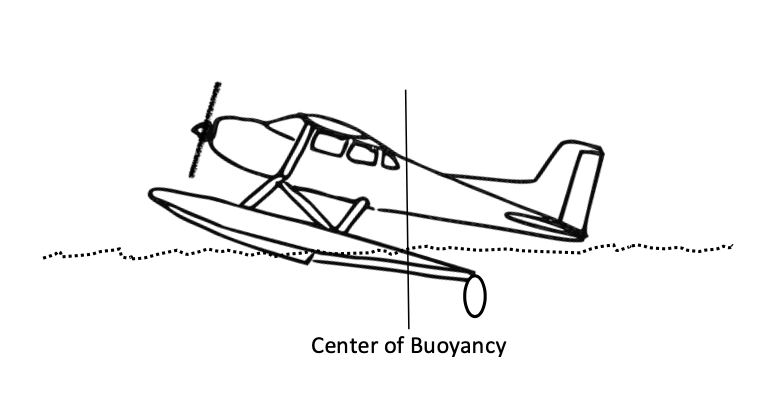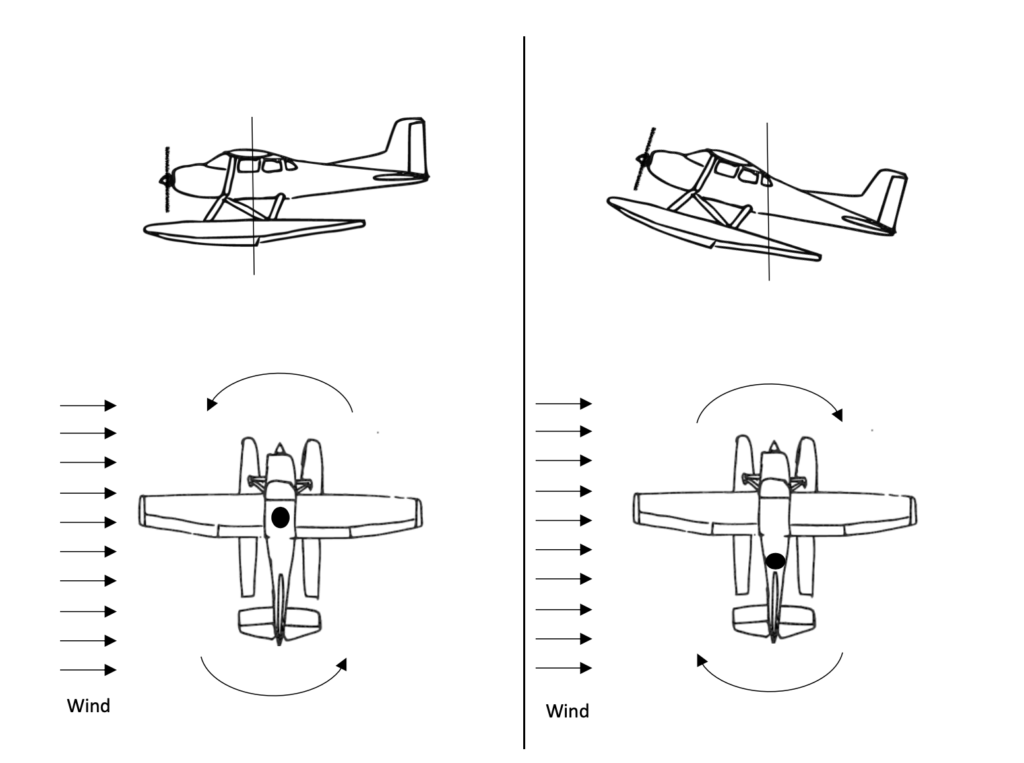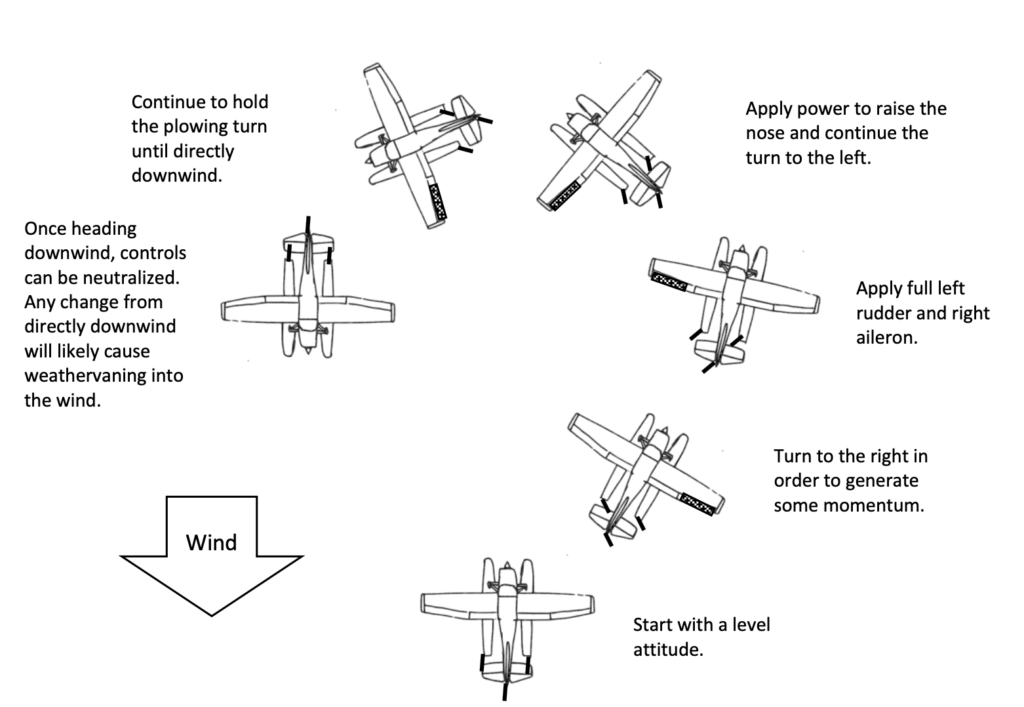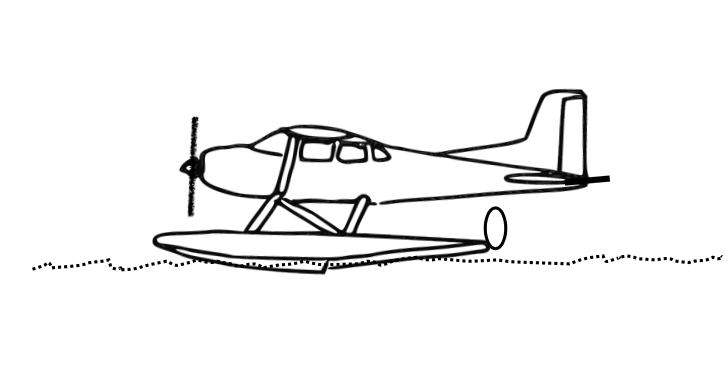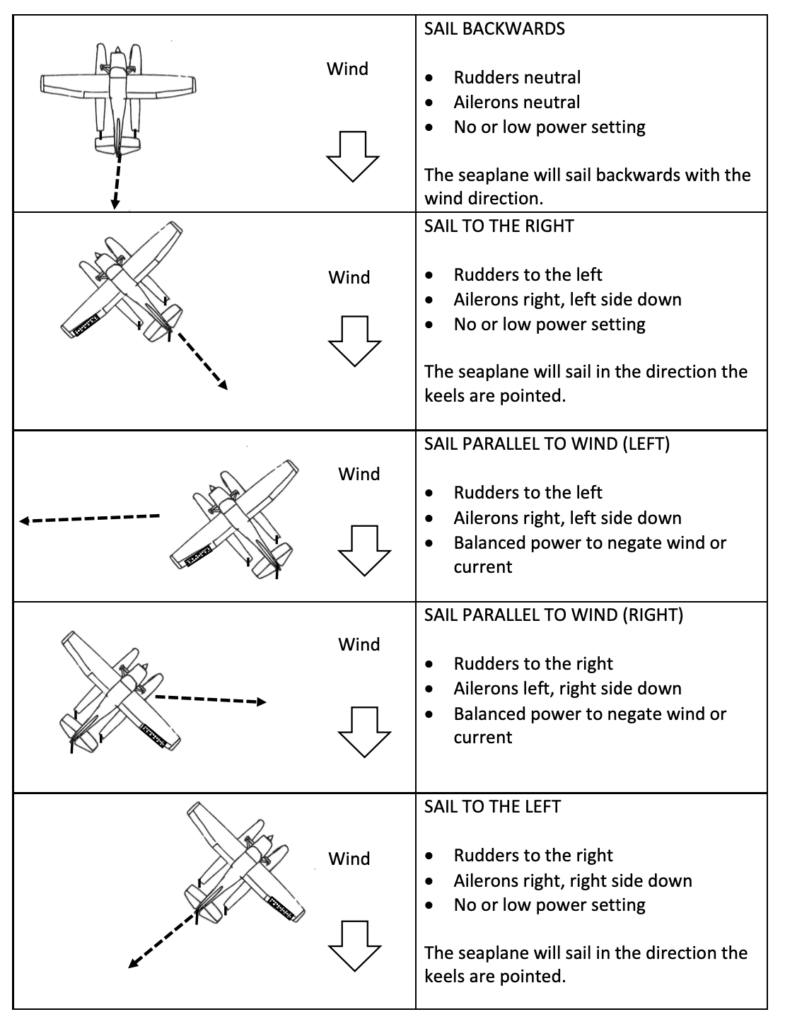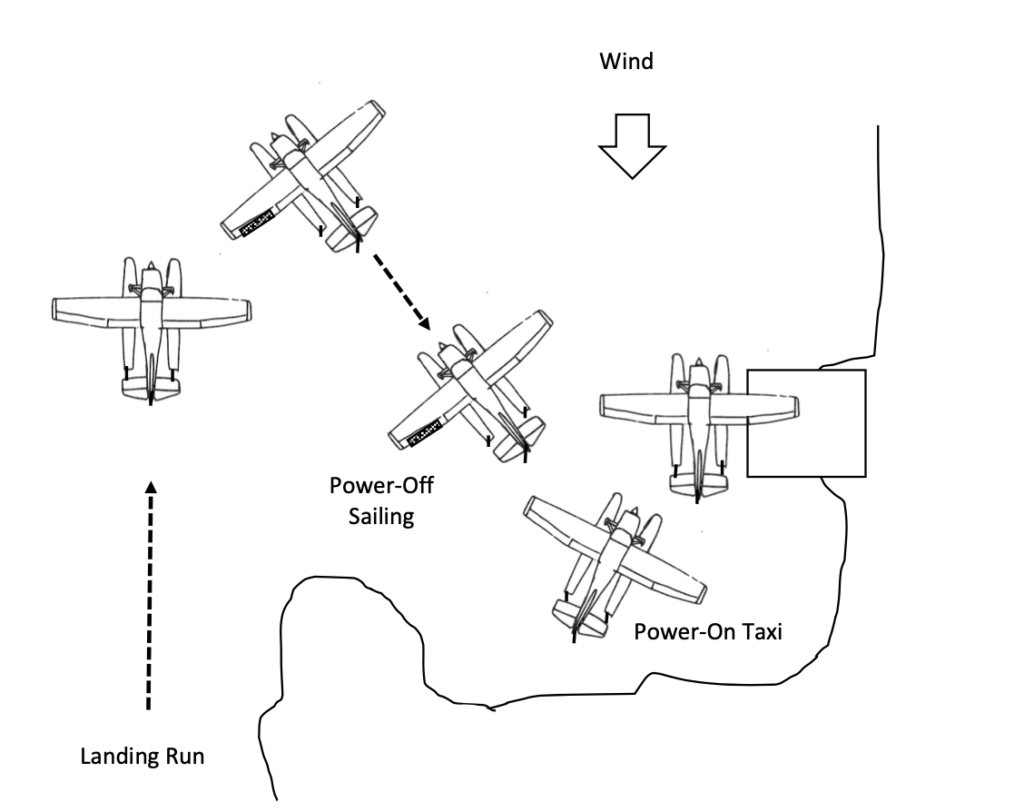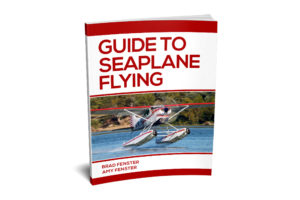Taxi Operations/Water Handling
Taxi operations with a seaplane have some unique characteristics. The seaplane pilot must know how to properly handle the aircraft. For all seaplanes, there are three primary taxi positions while on the water. These are the Idle or Displacement Taxi, Plow Taxi, and Step Taxi.
Seaplanes have a center of buoyancy during water operations. This is similar to the center of gravity with all airplanes. During water taxi operations, changes in pitch will change the center of buoyancy and the seaplane’s weathervaning characteristics. If the center of buoyancy is forward, it will weathervane into the wind. If the center of buoyancy is aft, it will weathervane away from or with the wind. In general, water rudders should be down while on the water unless conducting a step taxi or performing a takeoff run. There are a few exceptions, such as the start of a takeoff in high crosswinds.
Aileron control is a must while taxiing on the water. The concepts are the same as the landplane, but the consequences of poor pilot technique are more severe.
Idle Taxi (Displacement Taxi)
The idle taxi is the primary method of moving the aircraft on the water at slow speeds. When in an idle taxi, the seaplane will sit level in the water. During idle taxi, the all of the aircraft’s weight is supported by the floats. The water rudders are kept down to combat weathervaning. To minimize water spray on the propeller, the engine should be operated at less than 1,000 RPM. The low RPM helps keep the engine cool as there is little airflow at this speed.
Plow Taxi
The plow taxi should be avoided unless necessary to avoid obstacles. In a plow taxi, the elevator is pulled back and some power applied. These actions will raise the nose, which moves the center of buoyancy aft. In this position, the seaplane will weathervane with the wind, opposite of its normal behavior. This tendency can be useful if needed to avoid obstacles, especially when operating in windy conditions. However, it comes at a cost. The plowing position causes a lot of water spray and is hard on the engine due to the high-power settings and lack of cooling airflow. The nose-high attitude also makes it difficult to see in front of the aircraft. The plow taxi is primarily used to conduct a plow turn which is detailed in the next section.
-
- Weathervanes away from the wind
- Poor visibility due to the nose-up attitude
- Hard on the propeller due to water spray
- Hard on the engine due to lack of cooling
- Water rudders down
- Elevator up
Plow Turn
A plow turn is a method to turn the seaplane in the direction of the wind, overcoming the normal weathervane tendency. As the name suggests, this turn is accomplished in the plow attitude. The change in weathervaning tendency occurs as the center of buoyancy is moved aft, resulting in more surface area in front of the center of buoyancy. As a result, the seaplane will turn with the wind rather than weathervane into the wind. The following images show the turning tendency with the changes in the center of buoyancy. Notice the change in weathervaning tendency when the pivot point moves aft.
As with a plow taxi, plow turns are hard on the engine and propeller. Although plow turns should be avoided during normal maneuvering, if one is needed, proper technique is essential. As noted in the plow taxi section, the plowing position is damaging to the propeller due to water spray and is difficult on the engine as there is high power and low airflow.
If conducting a plow turn, the turn should be conducted to the left. The left turn uses the left-turning tendencies of the aircraft. As the plow turn is used to turn against the wind, getting all available assistance is beneficial. Although the overall turn is performed to the left, the initial turn is to the right, and then the momentum is used to bring the aircraft around. The turn looks much like a question mark if viewed from above. During this maneuver, proper aileron use is critical. As the maneuver is conducted in higher than normal winds, the windward wing must be kept from rising.
Step Taxi
The step taxi is used to move the aircraft on the water at higher speeds than the displacement taxi. To step taxi, the aircraft is operated at somewhere above 25 knots and less than takeoff speed, depending on the aircraft. The step taxi is essentially a takeoff run, but without actually taking off. Once on the step, the aircraft is in a planing position. At this point, the majority of the aircraft’s weight is supported by hydrodynamic lift the floats and aerodynamic lift from the wings. As discussed in the next section, turns from downwind to upwind should be avoided. In most cases, the water rudders are up during step taxi to avoid damage. During the step taxi, improper pilot technique may lead to porpoising or skipping, which are discussed separately. If step taxiing is frequently required, consider landing closer to intended destination.
-
- Water rudders up – avoids damage
- Elevator – slightly up
- Used to get places quickly when on the water
- Approximately 25 knots to < takeoff speed
- Avoid turns from downwind to upwind
During a step taxi, turns may be conducted, but there are some serious considerations.
- Step turns should only be conducted in no-wind conditions. Turns from downwind to upwind at high-speed should not be made. The wind and centrifugal force could capsize the seaplane. This type of turn should only be performed in calm or very light winds (as in a confined area takeoff).
- Full aileron input should be held in the turn. A primary concern is the combined effect of wind and centrifugal force. The inside wing should not be allowed to lift, and the outside float should not be allowed dig in.
- When feasible, turns should be made to the left. It gives better visibility and the left turning tendency of the aircraft helps to prevent the wing from lifting.
- Slowing the speed during a step turn results in a tighter turn.
- In general, step turns are safest when performed at the slowest possible speed.
Porpoising
Sometimes when on the step, during a step taxi or takeoff run, the seaplane may start to porpoise. A porpoise is caused when the nose is either too high or too low. This undesired condition usually relates to incorrect pilot input on the elevator. This commonly occurs when the seaplane completes its second rise during the takeoff run and the pilot either does not release pressure or pushes the nose over too much. The following are the pilot’s control actions for the various conditions.:
- If the nose is too low, correct by pulling back slightly.
- If the nose is too high, correct by releasing back pressure slightly.
Should the porpoising not stop quickly, cut power and return to a displacement taxi.
Skipping
Skipping is when the aircraft bounces from wave to wave. Although skipping can occur while on the step, it is more likely to occur with a poor aircraft attitude during landing. As such, skipping is discussed in detail under the landing section. Should skipping occur during a step taxi or takeoff run, power should be reduced, and the aircraft returned to a displacement taxi.
Amphibian Taxi
There are some additional items related specifically to taxiing an amphibious aircraft. These include the following:
- While on land, minimize braking action. Using some power creates a blast of air before a turn to make the air rudder more effective.
- Do not taxi too fast, as the nose wheel may start to shimmy and can cause significant stress and damage to the float structure.
- Do not ride the brakes. New seaplane pilots tend to maintain too much power during the taxi and then maintain brake pressure at the same time.
- Taxiing in a crosswind may blow the front of the aircraft with the wind due to the large amount of surface area and the lack of rudder authority at slow speeds.
- Be careful if there is a significant change in grade. There is not much clearance under the floats between the front and rear wheels. Avoid becoming high centered.
- Enter the water very slowly. The bows of the floats may initially submerge when going from a ramp to the water.
- After entering the water, ensure to retract the landing gear.
Sailing
Sailing allows the seaplane to move backwards or sideways depending on the use of power, if any. Sailing provides alternatives to the pilot instead of taxiing downwind. In most cases, sailing should be used instead of a plow turn.
- Sailing is useful on windy days to let the plane drift backwards instead of trying to fight the weathervaning tendency.
- The engine can be shutdown. Optionally, sailing with the engine at idle can allow the plane to maneuver sideways. Varying the engine speed allows the plane to move forward, sideways, or backwards. Running on one magneto helps reduce engine power even more. ENSURE BOTH MAGS ARE TURNED ON PRIOR TO TAKEOFF.
- The water rudders should be retracted. When sailing, the direction of the water rudders conflicts with the direction of the air rudder.
- The tail of the plane should be pointed in the required direction by using the rudder, then ailerons turned in the opposite direction. The down aileron causes more drag and should help to maintain the desired direction.
- The landing and taxiing should be planned to minimize the amount of sailing needed. It is easier to sail backwards 100 feet than one mile.
The keel effect helps keep the plane sailing in the direction of the floats. Other factors removed, the aircraft wants to move in the direction of the keel. If the wind is extremely strong, it may overpower the keel effect and the aircraft may move sideways. However, most pilots will not be operating in such winds.
The following are different aircraft controls to sail in different directions with the same wind.
Unless sailing directly backwards, controls will be crossed. To move in the opposite direction, the controls would be reversed. However, most sailing would be done backward and to one side, such as backing into a protected cove. It is easier to keep the keels pointed in one direction and modify power than to try and point the keels in the opposite direction. With proper planning, the pilot can minimize the amount of sailing.
TIP: To help remember the aileron positions, it can be helpful for the new seaplane pilot to use the rudder to point the nose and then use ailerons in the opposite direction.
The following is an example of using sailing and power-on taxi to access a dock that is somewhat protected by the land. Through a combination of power-off sailing and power-on taxiing, the pilot can navigate the seaplane safely to many tight spaces.
DEFINITIONS:
Center of Buoyancy: The average point of buoyancy in floating objects. Weight added above this point will cause the floating object to sit deeper in the water in a level attitude.
Displacement Position: The attitude of the seaplane when its entire weight is supported by the buoyancy of the floats, as it is when at rest or during a slow taxi.
Idling Position: The attitude of the seaplane when its entire weight is supported by the buoyancy of the floats, as it is when at rest or during a slow taxi. Also called the displacement position.
Keel Effect: When sailing, this force aligns movement of the aircraft along the water in the direction of the keels.
Planing Position: The attitude of the seaplane when the entire weight of the aircraft is supported by hydrodynamic lift, as it is during high-speed taxi or just prior to takeoff. This position produces the least amount of water drag. Also called the step position, or on the step.
Plowing Position: A nose-high, powered taxi characterized by high water drag and an aftward shift of the center of buoyancy. The weight of the seaplane is supported primarily by the buoyancy and partially by hydrodynamic lift.
Porpoising: A rhythmic pitching motion caused by an incorrect planing attitude during takeoff.
Sailing: Using the wind as the main motive force while on the water.
Skipping: Successive sharp bounces along the water surface caused by excessive speed or an improper planing attitude when the seaplane is on the step.
Step Position: The attitude of the seaplane when the entire weight of the aircraft is supported by hydrodynamic and aerodynamic lift, as it is during high-speed taxi or just prior to takeoff. This position produces the least amount of water drag. Also called the planing position.
QUESTIONS:
Why would a pilot conduct a plow turn? The plow turn is used to turn downwind when the water rudders are ineffective.
Why should a pilot avoid a plow taxi? Plow taxiing can cause damaging spray on the propeller and heats up the engine due to low airflow. If there is enough wind to warrant a plow taxi, sailing is often the better option.
Why does the plane turn downwind when conducting a plow taxi and into the wind during idle taxi? The reason the plow taxi turns downwind is that the center of buoyancy is further back. With the center of buoyancy further back, there is more surface area in front of the pivot point. The wind acting on this part of the aircraft will point it downwind.
At what speed should a step taxi be conducted? A step taxi is conducted at a speed that ensures that aircraft is on the step (generally greater than 25 knots) but less than takeoff speed. New pilots should use the minimum speed so as to avoid an inadvertent takeoff.
How does the pilot handle porpoising during a step taxi? If the seaplane begins to porpoise, determine if it is because the nose it too high or too low. If too high, elevator pressure should be decreased. If the nose is too low, aft elevator pressure should be increased. If pilot actions do not diminish the porpoising, the power should be reduced to idle. DO NOT try to counteract the porpoising with varying control inputs. It is very difficult to time correctly and will usually increase the problem.
When might a pilot raise the water rudders during an idle taxi? Water rudders may be raised during idle taxi to allow the aircraft to pivot into the wind rather than move in an arc. It can also be helpful to confirm the wind direction.
What direction are plow turns usually made? Due to the left turning tendency of the airplane, plow turns are much easier to the left. Plan all taxi maneuvers to be accomplished in the easiest way.
When would a pilot taxi with the water rudders up? Water rudders should be retracted when step taxiing, sailing, or in idle taxi through vegetation.
When sailing, why are the water rudders up or retracted? When sailing, the water rudders work in contradiction with the air rudder.
Why might a pilot lower the flaps when sailing? In order to increase sailing speed, the flaps may be lowered to increase the surface area affected by the wind. The doors may be opened as well.
What is the purpose of the ailerons while sailing? Aileron inputs increase drag which helps point the tail of the aircraft in the desired direction. The down aileron moves more than the up aileron, so the down aileron creates more drag. In addition, proper aileron use helps keep the upwind wing from rising.
When on the step, what is supporting the weight of the aircraft? While on the step, the aircrafts weight is supported by hydrodynamic lift from the floats and aerodynamic lift from the wings. During an idle taxi, the weight of the aircraft is supported by the displacement of the floats.


